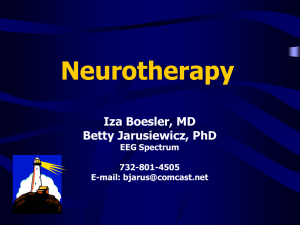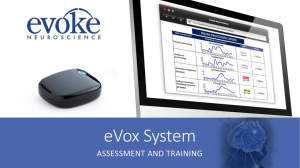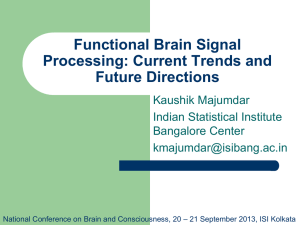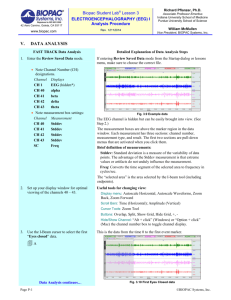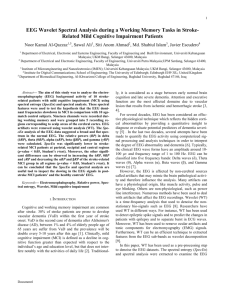EEG and Biofeedback Experiments:
advertisement
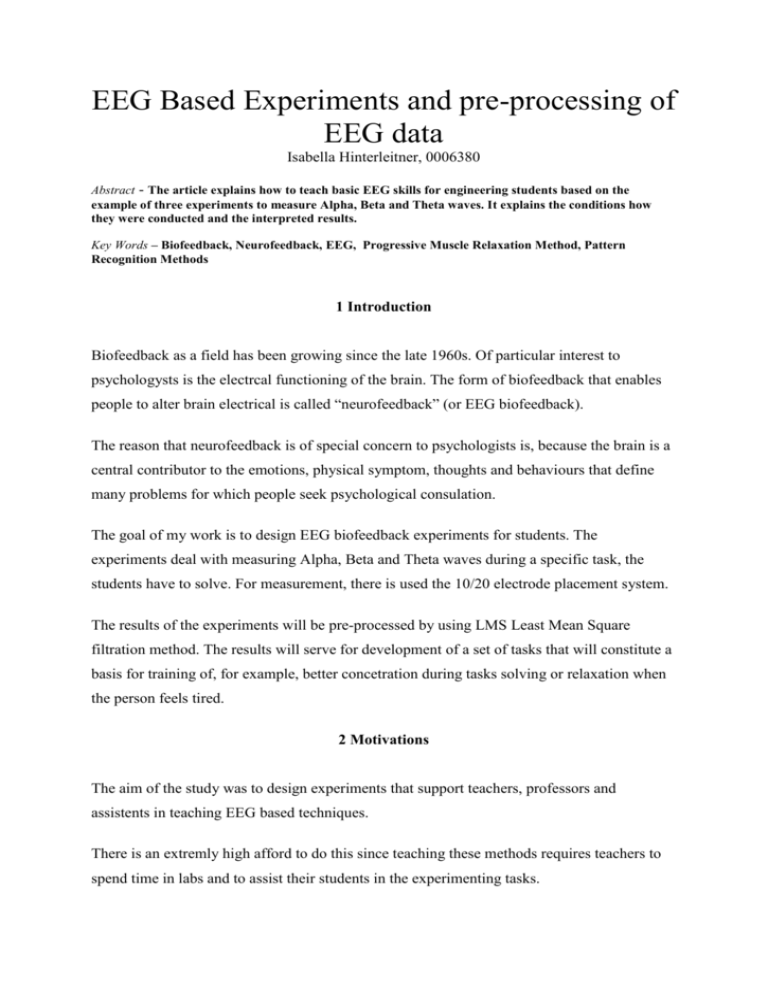
EEG Based Experiments and pre-processing of EEG data Isabella Hinterleitner, 0006380 Abstract - The article explains how to teach basic EEG skills for engineering students based on the example of three experiments to measure Alpha, Beta and Theta waves. It explains the conditions how they were conducted and the interpreted results. Key Words – Biofeedback, Neurofeedback, EEG, Progressive Muscle Relaxation Method, Pattern Recognition Methods 1 Introduction Biofeedback as a field has been growing since the late 1960s. Of particular interest to psychologysts is the electrcal functioning of the brain. The form of biofeedback that enables people to alter brain electrical is called “neurofeedback” (or EEG biofeedback). The reason that neurofeedback is of special concern to psychologists is, because the brain is a central contributor to the emotions, physical symptom, thoughts and behaviours that define many problems for which people seek psychological consulation. The goal of my work is to design EEG biofeedback experiments for students. The experiments deal with measuring Alpha, Beta and Theta waves during a specific task, the students have to solve. For measurement, there is used the 10/20 electrode placement system. The results of the experiments will be pre-processed by using LMS Least Mean Square filtration method. The results will serve for development of a set of tasks that will constitute a basis for training of, for example, better concetration during tasks solving or relaxation when the person feels tired. 2 Motivations The aim of the study was to design experiments that support teachers, professors and assistents in teaching EEG based techniques. There is an extremly high afford to do this since teaching these methods requires teachers to spend time in labs and to assist their students in the experimenting tasks. By designing these experiments it was taken in account that teachers have a lot of students to supervise and little time to actually assist them. I tend to prefer the method of student tutoring where younger students learn from older students. The article explains three basic EEG experiments in depths and explains how teachers can conduct them. Morover it gives an opprtunity for extension and deepening the work by mentioning some extra tasks. To control the lab work it is assumed that the student monitor their results via a lab protocol. In each group there sould be at least one patient, a coordinator, whose task is to read the tasks to the patient and a protocoll writer. So the minimum group size will be three people. The tutors should supervise the work of the students done in the lab course – the actual measurement and the pre-processing of the data in MatLab. The professor is able to review the results via the posting of the students in an online forum and gets an overview of the work at the final examination. 3 Methods The first experiments deal with measuring Alpha waves using the 10/20 electrode placement system [5], which means that the electrodes are placed on the head at specific locations that are 10% or 20% of a measured length from a known landmark on the head. The eqippment supplied will be an EEG measuring device, which can be accessed by the students in the labratory environment. The goal is that by using Muscle Relaxation Method the patient should get into a relaxed state. Progressive Muscle Relaxation is a method used where patients relax their muscles step by step until their whole body is relaxed. It is used to decrease stress. [6] The duration of the experiment will be 20 minutes. Figure 1 - EEG Measurement Device To produce modifications, the tested person varies with either eyes staying open or eyes staying shut. There should be a different result due to this condition, which will be evaluated by the students in a protocol. The second experiment deals with measuring Theta wave [1], with a frequency band between 4-8Hz. The goal is that the patient has to remind himself/herself of an emotional incident back in his past. The duration of the recalling process is limited with 5 minutes. During the recalling of the incident the person will be measured. The third experiment focuses on measuring Beta waves, when the frequency band is between 15-30Hz. The person has to solve an analytical mathematical problem during a given time. Though it is not important that the task is fullfilled with the correct result. The experiment takes 20minutes. Each of the experiments will be protocolled precisely by a student protocoll covering important parameters on the measuring situation. 4 Results The output of the experiments will be converted into .ASCI for further pre-processing in Mat Lab. The sampling frequency was set on 250 mHz. The result of the first experiment before filtering should be examined from the the students as regards artefacts, sich as blinking from the person who was measured. The blinking represents a good way to test, if the measuring device is working. Within the frame of the student experiments the filtering is done by using Mat Lab. The filter used will be a low pass filter with a sampling frequency of 128Hz. For pre-processing the meausred data students may use a special Mat Lab library for Filtering. The interpretion of the signal involves examining the quantification of the signal strenght and regognizing the different EEG patterns dependent on the frequency rate. Latter can be done by comparing the signal patterns to each other as it is done in figure 2 and 3 below. For further classification students use advanced methods, such as Local Neural Classifiers or Neural Networks. The result of the first experiment was concerned measuring Alpha waves. The experiment was carried out with eyes closed. Figure 2 Results of the first experiment - Alpha wave measurement Figure 3 - Table of Wavelengths - Alpha. Beta, Theta, Delta The students shall classify their results according to the characteristics of Alpha, Beta, Theta waves. See figure below. The second experiment was measuring Theta waves, where the student has to remind himself of a stressful incident, such as anger or grief. During the experiment he has his eyes closed and it is important not to move because of artefacts. Theta waves are in general measured during strong emotions but can also be encountered during sleep and daydreaming. The third experiment was concerned with measuring Beta waves. During the experiment the student had to calculate rows of numbers, which is presented by reading it to him. The student can not see the numbers in front of him. For example: 12+4-3+14-23+12-15. The student has his/her eyes closed during the experiment. Figure 4 Results of the third experiment - Beta Waves measurement Finally there will be a quantitative EEG analysis by quantifying the properties of measured EEG, using power spectral density and modelling the ouput of a time varying system. Successively there will be done the quantitative analsysis by quantifiying the properties of measured EEG signals. If the signal is stationary the quantitative analysis is done by power spectral density. The non-stationary EEG recordings shall be modelled as an output of a time Varying system. In the analysis pf non-stationary EEG it is important to estimate the time varying spectral properties of the signal. The time varying parameter estimation problem can be solved with adaptive algorithms, such as the least mean square (LMS) [2] or dividing non-stationary signals into stationary segments either adaptive or constant segmentation [3]. 5 Conclusions The eperiments provide an opportunity to the students to study the basics of EEG measurement and biofeedback. They may deepen their interest with further questions to the experiments in their research protocol. The experiments can be set in the frame of a semester project to encourage the students to get deeper into certain parts. An extension of the experiment is connceted with the study from A. Blood and R. Zatorre. [4] Their idea was to measure the chill effect, when someone listens to music he/she likes, by measuring for example the skin tension, pulse, heart rate and body temperature. The extension will be to measure the chill effect using EEG as a method of investigation. For this the students has to bring some sample music he/she likes in order to achive the effect. The students measured should be with musical background experience, as it was carried out in the scope if the experiment from 2001 done by A. Blood and R.Zatorre. The question is asked is, if it is possible to detect the chill effect by measuring the EEG. Finaly there should be an evaluation process of all experiments, where students have the opportunity to modify and make extensions if needed for understanding. The results of the students should be discussed with a tutor or teacher after each measuring step. At the end each student group presents the work in a student conference and will be examined crtically. References: [1] Cappa S.F., Cognitive Neurology An Introduction, Imperial College Press, 2001:82-85 [2] Olkkonen H., Pesola P, Valjakka A, Tuomisto L. Gain optimized cosine transform domain LMS algorithm for adaptive filtering of EEG. Comput Biol Med. 1999 Mar;29(2):129-36 [3] Rieger J., Lhotská L., Krajca V, Matousek M.; Application of Quantitative Methods in Signal Processing to Automatic Classification of Long-Term EEG Records. In: Biological and Medical Data Analysis. 2004, s. 333-343. [4] Blood, A. J., & Zatorre, R. J. (2001). Intensely pleasurable responses to music correlate with activity in brain regions implicated in reward and emotion. Proc Natl Acad Sci U S A, 98(20), 11818-11823. [5] http://www.piercecollege.edu/faculty/pandeyc/ElectrodePlacement.html Electrode Placement last accessed on 19.5.07 [6] http://www.breastcancer.org/comp_med_pmr.html What is progressive Muscle Relaxation Last accessed on 19.05.07

